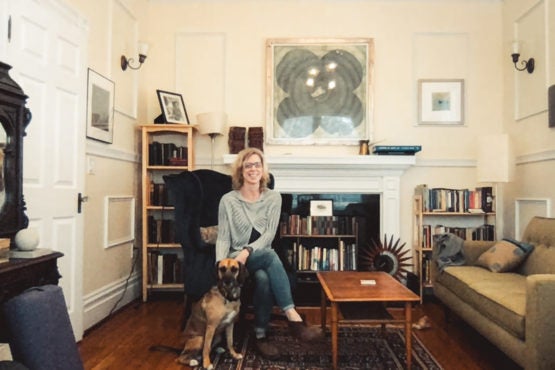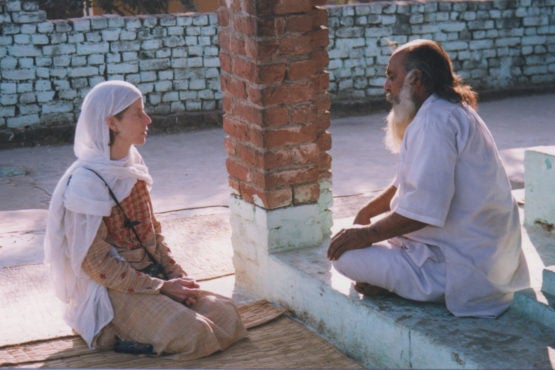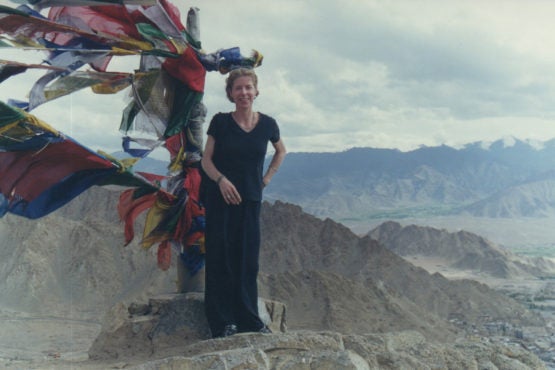Being in India when a Muslim holy site was destroyed led Anna Bigelow to spend her career thinking about shared sacred spaces
The violent destruction of a Muslim holy site in India prompted religious studies scholar Anna Bigelow to ask why some communities succumb to violence and others do not.
After graduating from Smith College with a degree in religious studies and English, Anna Bigelow had the opportunity to study for three months in India, a country that had captivated her interest as a student.

The experience of interreligious strife in India sparked for Anna Bigelow a scholarly interest in shared sacred spaces and religious plurality. (Image credit: Andrew Brodhead)
In 1992, Bigelow, now an associate professor of religious studies at Stanford, joined a Buddhist studies program housed in a Burmese monastery in Bodh Gaya, located in central northern India, where her days consisted of language, philosophy and anthropology classes and learning Buddhist meditation techniques.
Toward the end of that program, one of the most cataclysmic events in Indian history occurred. The Babri Masjid mosque was torn down by Hindu protesters who claimed that the mosque, which had stood since the 16th century, had been built over the birthplace of the Hindu god Rama.
The violent confrontation prompted other clashes throughout the country between Hindu nationalists and Muslims over religious sites. One happened just 2 miles away from where Bigelow was staying.
These events lingered in Bigelow’s mind long after she returned home and would come to shape not only her graduate studies but the rest of her scholarly life.
Studying religious pluralism
Upon returning to the United States, Bigelow began a master’s program at Columbia University, where she discovered abundant scholarship emerging about the riots that had enveloped India while she was there. Most of the research centered around why riots happened in certain places, but Bigelow was particularly struck by what wasn’t being discussed – namely, what it takes to keep the peace, particularly in a shared sacred space. After all, countless sites in South Asia have been places of peaceful communal worship for centuries.

Anna Bigelow speaking with the caretaker of a Sufi tomb shrine in Punjab, India, 2001. (Image credit: Courtesy Anna Bigelow)
“For many years even the Babri Masjid mosque had been shared,” said Bigelow, who joined the School of Humanities and Sciences in 2019. “That struck me as quite remarkable given that it’s not something you see a lot in the U.S. context.”
Fascinated by the idea of shared sacred spaces and religious plurality, Bigelow returned to India in 2000 as a doctoral student at the University of California, Santa Barbara, to delve more deeply into the complex relationship between Muslims and non-Muslims in the northern Indian region of Punjab. She was particularly eager to examine Muslim culture in India, because, at the time, most scholarship on Muslim life was focused on the Middle East.
It was on this trip that she was introduced to the Muslim-majority town of Malerkotla – a community where religious plurality is deeply ingrained into its history. In the early 18th century, the region was at war when the two youngest sons of a Sikh guru were seized by the opposing Mughal forces. A Muslim ally of the capturing force who was the ruler of Malerkotla tried to save them from execution.
Although the effort was unsuccessful, the Sikh guru heard of it and blessed the Muslim kingdom. According to local lore, it is that blessing that protected Malerkotla in 1947, during India’s partition from Pakistan and the ensuing violence, and continues to protect it today.
Brotherhood and harmony
Bigelow’s research at Malerkotla during her year-and-a-half there laid the foundation for her later work and is still a focus of her scholarship today. “I became very interested in the non‑event of violence and what makes this particular town so resilient,” she said.

Anna Bigelow in Ladakh, India, with Buddhist prayer flags in the background. (Image credit: Courtesy Anna Bigelow)
What she found was a commitment to making peaceful pluralism a priority through a set of shared understandings, identities, religious perspectives and religious sites. That initial research led to her first book, Sharing the Sacred: Practicing Pluralism in Muslim North India (Oxford University Press, 2010). “There was a collective identity structured around this idea of being a town based on brotherhood and peace and interreligious harmony,” she said.
Bigelow is currently working on her second book, which is a comparative study of shared sacred sites in India and Turkey. A trip to both countries to continue her research was postponed due to the COVID-19 pandemic.
“There are lots of local churches in Turkey that Muslims go to quite regularly, because they are the places you go to pray for certain things,” Bigelow explained. This is especially true of churches devoted to Mary or St. George, who is connected with the holy figure in Islam known as Hizir or Khidr.
“Most humans have the same problems and needs as other humans, whatever their religion. These places tend to bring people together across class, gender and religion,” Bigelow said. “In India, similarly, there are broad intersections of people who believe that there is something special there. That God is listening in these places more carefully than elsewhere.”
Religious pluralism today
Bigelow’s study of what makes religious pluralism successful has taken on more urgency lately as Turkey’s and India’s governments have moved to promote their majoritarian religions.
For example, India’s Citizenship Amendment Act, passed last year, made it possible for migrants from certain countries and religions to receive fast-tracked citizenship – with the exclusion of those practicing Islam. Across India, rallies and protests have taken place against the act.
Malerkotla, the town that inspired Bigelow’s lifelong interest in interreligious cooperation, has also been in the news again.
“Malerkotla has now become a regional center of activism against some of these anti‑Muslim policies and events,” Bigelow said. “There are sites where Sikhs, Hindus and Muslims are gathering together and having demonstrations, protests, poetry readings, street theater, and all kinds of creative and adaptive ways in which they are resisting the forces of polarization.”
For her part, Bigelow continues to be inspired by Malerkotla’s commitment to its history and the effort it takes for the community to maintain its identity in a changing world. “They’re reminding themselves about their own history of pluralism and multicultural brotherhood,” she said, noting that the town’s commitment continues to resonate in her work all these years later.
“I’m impressed by how people take this seriously as requiring effort. It’s not just something you can take for granted,” Bigelow added. “You have to keep working at it if this is the society you want. That’s been quite humbling and impressive to see and heartwarming also.”
Stanford Report is exploring the stories behind the curiosity and excitement that drives foundational discoveries in the arts, humanities, social sciences and sciences.
